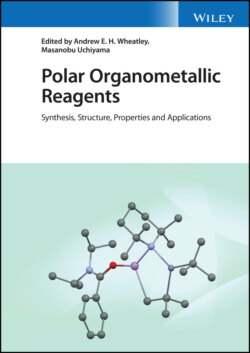Читать книгу Polar Organometallic Reagents - Группа авторов - Страница 13
1.1 Introduction
ОглавлениеMultifunctionalized organometallic species have played a vital role as versatile intermediates in modern synthetic organic chemistry for many years [1, 2]. Identifying a suitable metal and controlling reaction conditions have been crucial to underpinning the handling of functionalized organometallics because the reactivity and stability of these species and the effectiveness, selectivity, and safety of the process(es) by which they display metalation are strongly dependent upon the identity of the metal. This chapter describes the advent of controlled and selective metalation using traditional monometallic reagents but also outlines its limitations and the recognition that reactivity can be tuned by introducing a second metal centre. It was this view that eventually gave rise to a major theme of the current book; the concept of ate complexation of organometallics containing a very electropositive (highly reactive but perhaps unselective) metal using a more electronegative (less reactive, more selective) metal (Figure 1.1a). This idea led, in the late 1990s, to the use of not only organozinc halides or di‐organozincs but also of the development of organozincates and their extensive use in a range of organic transformations including nucleophilic addition, halogen–metal exchange, metal carbenoid synthesis, de‐protonative metalation, ring‐opening, and cross‐coupling [3]. The prolific ability of organozinc compounds and complexes to effect efficient yet highly selective transformations in tandem with inherent functional group compatibility resulted in great interest from synthetic chemists. In particular, because the latter characteristic feeds into applications in directed aromatic metalation, whereby a pre‐existing substituent on an aromatic ring acts as a directing group (DMG) to promote selective reaction. This is a methodology that has come to represent one of the most effective ways of regiospecifically elaborating functionalized aromatic systems and which has, over a number of years, focused on the strategy of achieving ortho reaction of said ring. Though this technique has come to the fore in the elaboration of both aromatic and heteroaromatic systems, the low acidity of the hydrogen atoms on aromatic rings has led to a dependence on organolithium reagents as the base of choice for effecting deprotonation [4–8]. However, the high nucleophilicity of these same organolithium reagents has brought with it the associated risk of competing reaction at the DMG itself. It was the need to overcome this synthetic limitation that led to the development of the heterobimetallic complexes alluded to above, designed to promote chemoselective directed metalation reactions under mild conditions on the grounds of reduced nucleophilicity. This has now seen a range of zincates and other metal ate complexes incorporating the sterically bulky (non‐nucleophilic) 2,2,6,6‐tetramethylpiperidide ligand (TMP) successfully used to elaborate functionalized aromatics incorporating DMGs normally susceptible to competing nucleophilic degradation. The first work in this field appeared in 1999 when Kondo and coworkers reported the directed zincation of a functionalized aromatic compound. This was achieved using the, at that stage, putative base t‐Bu2Zn(TMP)Li 1 (Figure 1.1b and Scheme 1.1) and avoided the normal (for organolithium reagents) requirement of temperatures below room temperature (r.t.) [9]. This key advance led to an explosion of interest in developing the concept of tunable ate complex reagents in directed metalation chemistry.
Figure 1.1 The general principles demonstrated by (a) a heterobimetallic ate complex designed for selective aromatic metalation, (b) as exemplified by the first reported example of such a complex, t‐Bu2Zn(TMP)Li 1.
Scheme 1.1 A generic directed ortho‐deprotometalation strategy incorporating 1.
